The theater with its festival and other essentials of Mérida's Roman past

Mérida is one of the most outstanding destinations in all of Extremadura thanks to its monumental complex, which earned it the title of World Heritage Site in 1993. This city offers one of the most complete views of ancient Roman life, as a walk through its layout reveals all the notable elements of an ancient metropolis, such as the theater, circus, bridges, forums, hydraulic works, temples , and even homes. Founded in 25 BC to house soldiers in the Cantabrian Wars and strategically located on the Vía de la Plata , Augusta Emerita experienced its period of greatest splendor in the 1st and 2nd centuries, hosting a population of up to 40,000 people, but its rich history continued to write interesting pages in the following centuries. For those planning a trip to the capital of Extremadura, these are the essential places to follow the trail left by the Roman Empire.
The Roman theater is the most representative element of Mérida's Monumental Complex. Its construction, according to the date inscribed on the theater itself, dates back to 15 and 16 BC. The work was carried out under the patronage of Marcus Vipsanius Agrippa —one of Emperor Augustus's close collaborators—when the colony was promoted as the provincial capital of Lusitania. Partially located on the slope of San Albín Hill, its design is based on the models defined by Vitruvius and has a Latin floor plan formed by four equilateral triangles inscribed within a circle, with the front of the stage at the base of the central triangle.
Over the centuries, it underwent various modifications, such as the construction of the great stage front—a 30-meter-high wall structured in two columns—carried out during the reign of Trajan . The three-tiered stands had capacity for 5,800 people , and spectators were distributed from bottom to top according to their social rank in three tiered sections: caveas suma, media, and ima, separated by aisles and barriers.
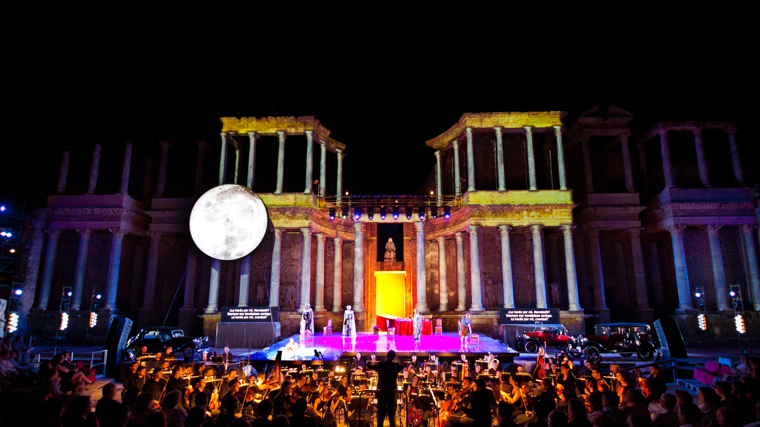 Performance of the Mérida International Classical Theatre Festival
Extremadura tourism
Performance of the Mérida International Classical Theatre Festival
Extremadura tourism
The first theatrical performance of the modern era took place in 1933 with a staging of Seneca's Medea in a version by Miguel de Unamuno, starring actress Margarita Xirgú. This marked the beginning of the Mérida International Classical Theatre Festival , the oldest theatre festival held in Spain. Currently, you can enjoy various performances throughout July and August. This season, the 71st, will feature ten shows, seven of them world premieres.
Built next to the theatre in the 8th century BC, this amphitheater, which could accommodate between 15,000 and 16,000 spectators , hosted gladiatorial games, wild beast hunts and fights between wild animals in settings that recreated forests, jungles and deserts. Today, only the cavea ima and some sections of the cava media are well preserved, but at that time it had four monumental doors that led to the arena, a seating area separated from the arena by a granite podium, a large pit where the wooden pillars that supported the platforms were located and under which the devices necessary for the development of the most complex spectacles were hidden, and a tribune for the magistrates.
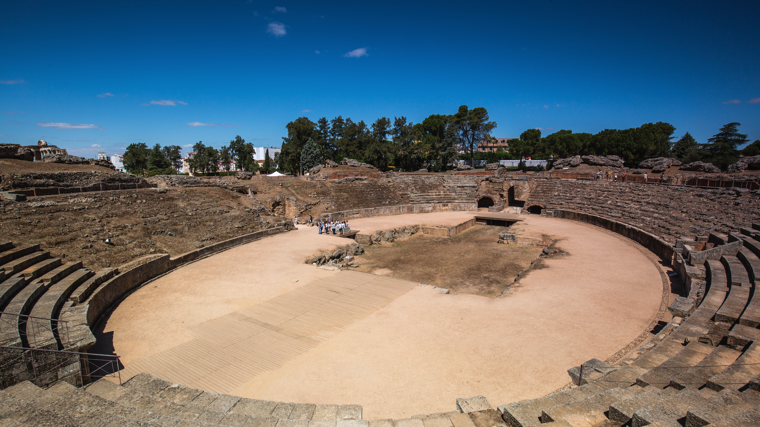 Image of the Roman amphitheater of Mérida
Extremadura tourism
Image of the Roman amphitheater of Mérida
Extremadura tourism
This aqueduct, built in the 1st century AD, is part of a hydraulic pipeline that brought water from the Proserpina Reservoir to the city of Augusta Emerita. It reached a limestone pool or reservoir where the water was decanted of its impurities. Known as "The Miracles" due to the fascination its excellent state of preservation caused among locals, this granite and brick construction is over 800 meters long and has 73 pillars —the purpose of which is to span the Albarregas River, which flows into the Guadiana—and reaches a height of 25 meters in one area.
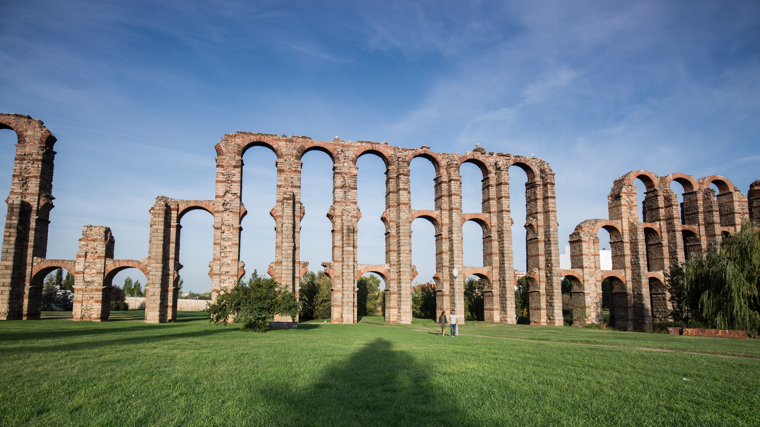 Image of the Aqueduct of Miracles, Mérida
Extremadura tourism
Image of the Aqueduct of Miracles, Mérida
Extremadura tourism
The Temple of Diana , which is in an exceptional state of preservation due to its centuries-long service as the foundation and framework for the Renaissance palace of the Count of Corbos , stands out within a large square known as the "Forum of the Colony," a space surrounded by important public buildings that served as the urban center and the main meeting point for the local inhabitants. Rectangular in plan, it rises on a granite podium ending in moldings, and above it sits the colonnade, whose granite drums were stuccoed and painted. On the front, six columns can be seen on which the tympanum rested.
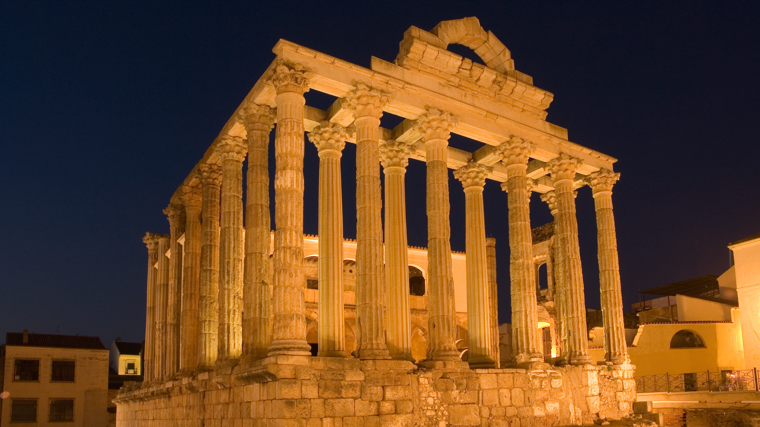 Night view of the Temple of Diana
Extremadura tourism
Night view of the Temple of Diana
Extremadura tourism
The forum portico , which was part of the propaganda program of the ancient Municipal Forum of August Emerita and is located on Sagasta Street, was built in the mid-1st century in the image and likeness of the Forum of Augustus in Rome. It was entirely clad in marble, which is still visible in some areas today. The entablatures are supported by large Corinthian columns on which rests an attic with metopes alternating medallions with heads of Jupiter-Amun, Medusa, and caryatids carrying kraters.
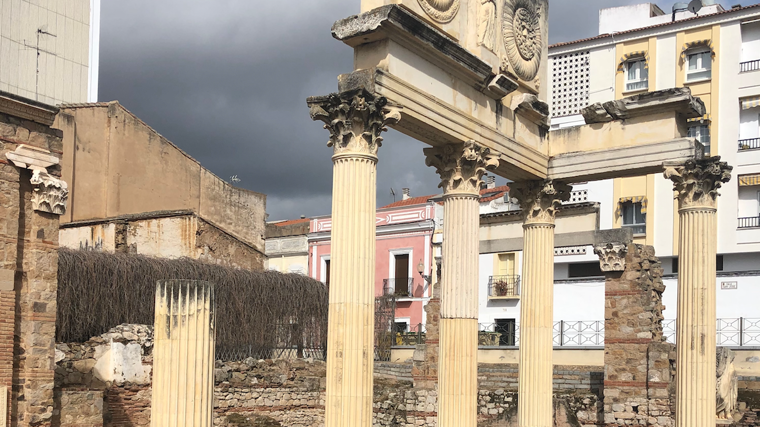 Image of the Portico of the Forum, Mérida
Rocio Jimenez
Image of the Portico of the Forum, Mérida
Rocio Jimenez
Known in Roman times as Anas, this bridge, at 792 meters long , is one of the longest of the ancient bridges, a crucial element for trade and a work that gives meaning to the existence of this city. Built entirely of concrete lined with granite ashlars, it is currently composed of 70 semicircular arches and reaches twelve meters high at its highest points. The sturdy pillars on which these arches rest have rounded cutwaters upstream in those sections that could be most affected by the current. Battles and flooding of the Guadiana destroyed some sections, which is why it has been rebuilt several times from the Visigothic period to the 19th century, the most important being in the 17th century, when five arches were added to its central span.
In its original state, it consisted of two bridges connected on the island by a large breakwater where a livestock market was held and which, like a wedge, divided the current of the Guadiana in two.
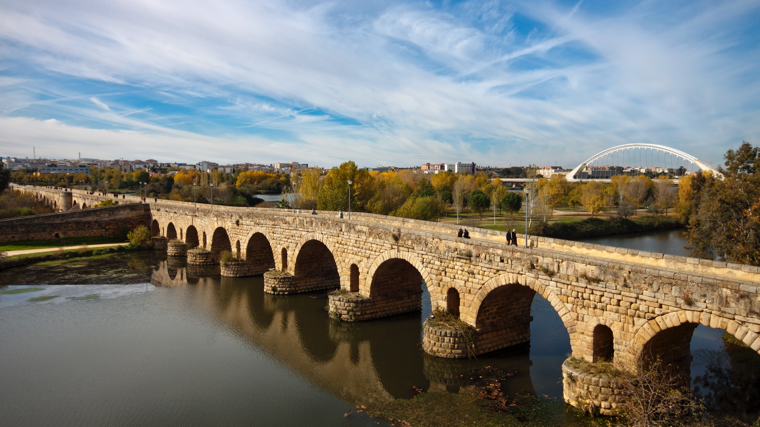 Image of the Roman Bridge of Mérida
Extremadura tourism
Image of the Roman Bridge of Mérida
Extremadura tourism
The Mérida circus is one of the best-preserved circuses of the Roman Empire, as well as one of the most grandiose, as it is 403 metres long by 96 metres wide and could accommodate up to 30,000 spectators . Located next to the Toledo and Córdoba road, taking advantage of the slope of the San Albín hill, it was built during the Julio-Claudian dynasty, but underwent several modifications over the years, the last being in the 4th century AD.
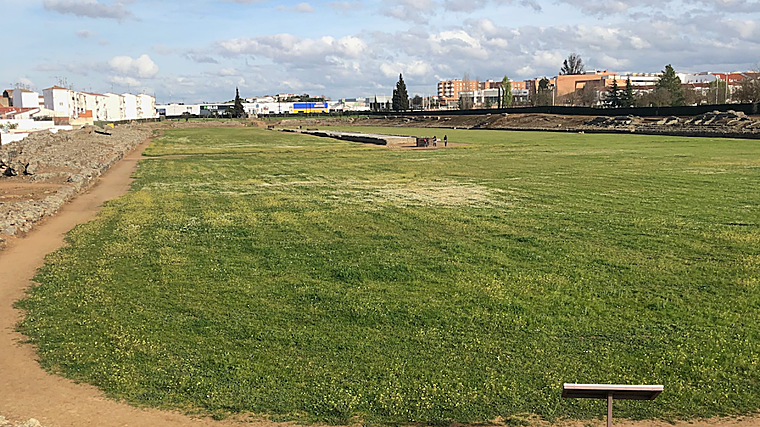 Image of the Roman Circus of Mérida
Rocio Jimenez
Image of the Roman Circus of Mérida
Rocio Jimenez
A walk through its interior, which was once an arena, gives an idea of what the spectacles must have been like. At the northwestern end were the cages for the chariots' departure, while at the other end was the gate through which the victorious charioteers emerged.
ABC.es





